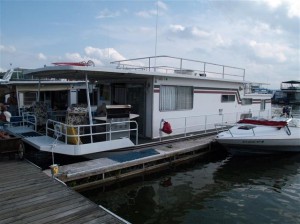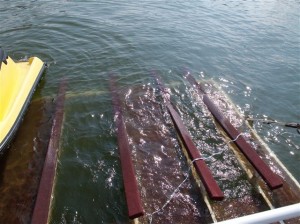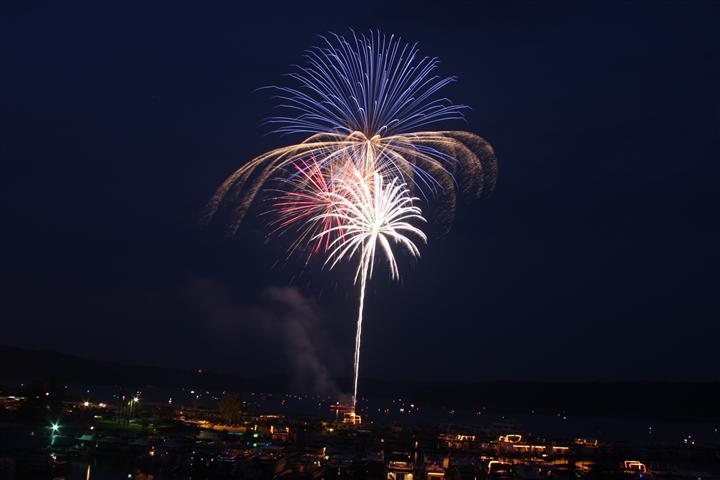Posted by Alisha on Aug 13, 2010
Dates are now set for the waterfowl blind drawings for the Doug Travis, Lake Barkley, Barren River Lake and Green River Lake Wildlife Management Areas (WMAs). Hunters interested in registering for the waterfowl blind drawings must be at least 18 years of age and possess a valid 2010-2011 Kentucky hunting license, a Kentucky waterfowl permit and a federal migratory bird permit (waterfowl stamp permit) at the time of the drawing.
The waterfowl blind drawing for Doug Travis WMA in Carlisle and Hickman counties will be Saturday, Aug. 28. The drawing will be held at the WMA office, located ½ mile south of Berkley on KY 123. Registration begins at 9 a.m. Central time with the drawing at 10 a.m.
The Lake Barkley WMA waterfowl blind drawing will be at 8 a.m. Central time Monday, Sept. 20. The drawing will be held at the shelter on the east side of the Cumberland River, located at Barkley dam off U.S. 62 near Lake City. Use the power house entrance and then turn right toward the drawing location.
The Green River Lake WMA waterfowl blind drawing will be Saturday, Sept. 25. The drawing will be held at the Green River Lake Corps of Engineers office pavilion, located off KY 55 approximately seven miles south of Campbellsville. Registration is 9 a.m. Eastern time with the drawing at 10 a.m.
The Barren River Lake WMA waterfowl blind drawing will be from 7 to 9 a.m. Central time on Saturday, Oct. 2. The drawing is being held at the Barren River Lake Corps of Engineers office at Barren River Lake dam, located off KY 252.
The waterfowl blind drawing date and location for Sloughs WMA will be announced at a later time.
Read More
Posted by John Humphress on Aug 5, 2010
FRANKFORT, Ky -– Kentucky’s fall squirrel season opens Sat., Aug. 21 and the outlook is similar to last year.
“Squirrels are our most stable and abundant small game species,” said Ben Robinson, small game biologist for the Kentucky Department of Fish and Wildlife Resources. “Even a poor mast year is not going to be detrimental to squirrel populations.”
This year, the 190-day season is split. The first segment of squirrel season opens Aug. 21 and closes for the opening weekend of modern gun deer season Nov. 13-14. Squirrel season opens again Nov. 15 and continues through Feb. 28, 2011. The daily bag limit is six squirrels.
Last year’s mast crop, the abundance of nuts and fruits produced by trees and other plants, determines this year’s estimate of the number of squirrels available to hunters.
“Last year’s mast crop was rated poor to average,” said Robinson. “Only 38 percent of white oaks observed had mast, 42 percent of red oaks, 27 percent of hickories, and 38 percent of beech.”
Since 1953, wildlife biologists have conducted a survey of Kentucky’s most important producers of wildlife foods, determining the proportion of mast bearing trees. Squirrels rely on the mast from these trees during various times of the fall and winter. “Since we did not experience a failure of any of these important mast crops, at least some food was available to squirrels throughout a majority of the winter months,” said Robinson.
Early in the fall season, squirrels feed heavily on hickories. A good hunting strategy is to look for trees with maturing nuts that squirrels are beginning to cut. Often these trees are on dry, upland sites, such as hilltops, or flat benches along the contour of ridges.
Shotguns are a good choice for early-season squirrel hunting since leaves make it difficult to clearly see squirrels.
But, the abundance of leaves also provides hunters with some advantages: squirrels make a lot of noise when they jump from limb to limb, and rustling leaves help hunters locate squirrels in the crowns of tall trees.
“The leaves also give hunters some cover as they slip around the woods,” said Robinson.
To help determine the health of Kentucky’s squirrel population, the Squirrel Hunting Cooperator Survey was developed in 1995 as a volunteer initiative. Biologists use the collected data to monitor squirrel population trends in Kentucky. Each year, participating hunter cooperators are mailed a new hunting log, the results of the survey and a small gift for participating, such as lapel pin or ball cap.
Hunters simply record the information about their hunts as the season progresses, then mail their survey to the Kentucky Fish and Wildlife when they’re finished hunting for the season. The mailing address is: No. 1 Sportsman’s Lane, Frankfort, Ky., 40601. Logs must be sent no later than May 31, 2011.
The recently published 2009-10 Squirrel Hunting Cooperator Survey Report, compiled by Robinson, offers some interesting data on Kentucky’s squirrel populations and the state’s most avid squirrel hunters.
Here are some highlights:
- The 109 squirrel hunters who participated in last season’s survey averaged about 12 hunting trips per season. Trips afield lasted an average of 2.6 hours each.
- Data included 1,319 hunts in 91 different counties across Kentucky.
- Hunters observed an average of nearly five squirrels per hunt and roughly two squirrels per hour. Hunters saw more than three times as many gray squirrels as fox squirrels.
- Robinson predicts hunters should expect to see nearly two squirrels per hour of hunting during the upcoming 2010-11 season.
- Harvest averaged between two and three squirrels per hunt and hunters bagged four gray squirrels for every one fox squirrel. The number of gray squirrels seen and harvested per hour was up slightly from the 2008-09 season. Hunters harvested nearly 51 percent of all squirrels observed.
- Hunting effort was greater toward the beginning of squirrel season, with 53 percent of the hunts taking place in August and September. Overall, 77 percent of all hunts occurred before opening day of modern firearms season for deer last year.
- Statewide, gray squirrels comprised 80 percent of the harvest. More fox squirrels were taken in central Kentucky, 24.5 percent, than any other region. Hunters in western Kentucky accounted for just a little over 10 percent of the fox squirrel harvest.
- September was the most productive month for squirrel hunters last season, with the highest number of squirrels seen and killed per hunt.
To participate in the 2010-11 Squirrel Hunting Cooperator Survey, please print a copy of the survey at: www.fw.ky.gov/smallgamelogs.asp, or call 1-800-858-1549 and ask for one to be mailed to you.
Art Lander Jr. has been writing about the outdoors since the 1970s. He is an information specialist with the Kentucky Department of Fish and Wildlife Resources.
Read More
Posted by John Humphress on Aug 1, 2010

Emerald Isle Resort and Marina
(Campbellsville, KY,) – Two people were almost electrocuted while swimming from the back of their houseboat Saturday afternoon around 3pm at Green River Lake. Beth Waite was swimming at the back of her boyfriend’s houseboat at Emerald Isle Marina when someone noticed Beth arch backwards and sink underwater. She managed to surface long enough to call for help. John Childress of Versailles, Ky. was helping the houseboat owner Bobby Gullett, work on his boat when he heard Beth’s cry for help. John then stepped onto the jet ski ramp on the back of the houseboat to pull Beth in when he noticed an electrical shock to his legs. He then reached out to grab Beth but received an even greater electrical shock and was unable to pull her to the boat. He then told Bobby Gullett, the houseboat owner to call 911 and to turn off all the electricity. Bobby shut off the main breaker and jumped into the water to save Beth and was instantly incapacitated from the electricity still flowing in the water. John was able the use a rope to grab Beth and Bobby and pull them back aboard the houseboat. Another houseboat owner saw what was happening and tried to swim over to assist but had to turn back around due to the electrical current in the water.
Beth Waite, age 42 was flown to U of L Hospital by Air Evac and Bobby Gullett, age 47 was transported to Taylor Regional Hospital by Campbellsville-Taylor County Rescue. Both were later released.
Electricians were called to find the source of the electric discharge and it was determined that the owners houseboat was the source of the electrical discharge into the water. His houseboat was disconnected from the dock until repairs could be made.

Bobby Gullett's Houseboat

Jet ski ramps at back of the houseboats.
Posted by Alisha on Jul 16, 2010
When you open a jar of Bowker’s dip bait, the reek from it all but scalds the olfactory nerves in your nasal passages. It smells really, really bad. A wind induced blast of its rank odor can turn a weak stomach. You can’t keep the jar open long because the stuff is too vile.
It catches the fire out of stream channel catfish.
Blue braids wind all over a map of Kentucky, showing the myriad streams and rivers of our state. Kentucky streams with pools 6 feet deep hold surprising numbers of channel catfish.
“Channel catfish can survive anywhere a bluegill or a longear sunfish can survive,” said Ron Brooks, director of fisheries for the Kentucky Department of Fish and Wildlife. “Channel catfish are naturally a river and stream species. They evolved in the rivers.”
Read More
Posted by Alisha on Jul 8, 2010
Kentucky is blessed with a diversity of wildlife – some 74 species of mammals, 380 species of birds, and 112 species of reptiles and amphibians.
Many of the state’s outdoor enthusiasts encourage wildlife on their property and spend countless hours and considerable sums of money, to get close to nature and its wild creatures.
But, when a family of raccoons takes up residence in the attic, or an opossum spends more time in your garage than the family car does, it doesn’t take long for these uninvited guests to become a nuisance.
That’s when it’s time to call the local Nuisance Wildlife Control Operator.
Read More






